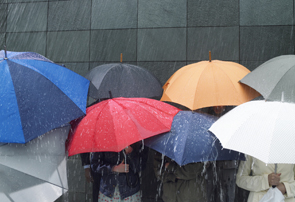The wettest start to the summer for almost a century
Release Date 02 July 2012

Nearly three times as much rain fell in Reading in June compared to the average for the month, according to meteorologists at the University of Reading.
The second wettest June in Reading in almost a century added to the miserable April and May weather to make the three-month period to June the rainiest late spring/early summer on record for 90 years.
A total of 123.2 mm of rain (corresponding to about 2.7 times the June average) fell at the University of Reading during June, making it the wettest June in the town since 1971, when 155 mm of rain was measured. In fact, in the past 90 years only June 1971 was wetter.
Roger Brugge, from the University of Reading's Department of Meteorology, said unusually for a wet June, persistent rain was to blame rather than thunderstorms.
Dr Brugge said: "Usually, one or two heavy thunderstorms are the reason for having a wet June. In 2012, however, no thunder was heard at the University while rain fell on 17 days with the longest rainless spell lasting just two days. This year much of the rain was brought by depressions and frontal systems - pushed towards southern Britain by the jet stream."
"June was slightly wetter than April - and the three-month period April to June 2012 brought 265.5 mm - the wettest such late spring/early summer in the past 90 years. Not surprisingly then, the perception of the start of this summer has justifiably been a poor one - with just a week of hot weather in late May seeming to break the wet spell.
"We saw a return to drier conditions during the final week of June, and fortunately in Reading we escaped the very heavy and damaging falls that affected some other parts of Britain."
The 10th-11th was the wettest two-day period during the month, giving a rainfall in 48 hours equivalent to the normal amount expected during the whole of June.
The same cloud that brought the rain has also been keeping the sunshine away. We had just 130 hours of sunshine in June - making the month duller than each of March, April and May this year. The June total was about two-thirds of the average June sunshine duration - making it the dullest June since 1991 with eight days failing to register one hour of sunshine.
The lack of sun also meant a cool month. June was the coldest since 2002 and only one day passed 25 degC. The month was 0.9 degC colder than average and ground frosts were measured on four mornings - the most in any June for seven years. Gardeners should note that in sheltered parts of Reading ground frosts can occur in any month of the year.
ENDS
For more details, please contact Pete Castle at the University of Reading press office on 0118 378 7391 or p.castle@reading.ac.uk.
Notes for editors
This note is based upon observations made at the University of Reading by the observer, Mike Stroud, and his colleagues.
While this June is the second wettest for 90 years, in earlier years June 1903 is recorded as the outstandingly wet June in the region. That year there was about 60 hours of near continuous rain from the 13th to the 15th in East Berkshire and the Thames flooded in many places as a result.
The University of Reading is ranked as one of the top 25 universities in the UK by both the Guardian and Times university guides and is listed among the top 1% of universities in the world (THE World University Rankings 2011-12). Reading is home to both the world-renowned Department of Meteorology and the Walker Institute for Climate System Research.